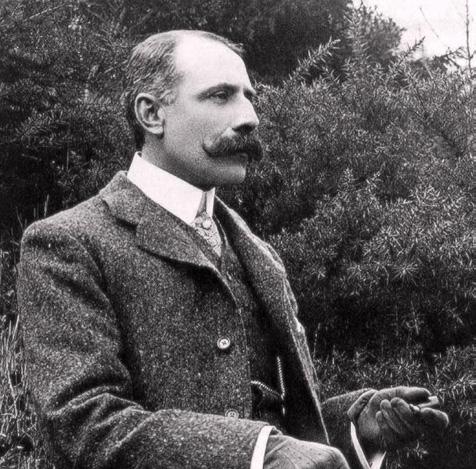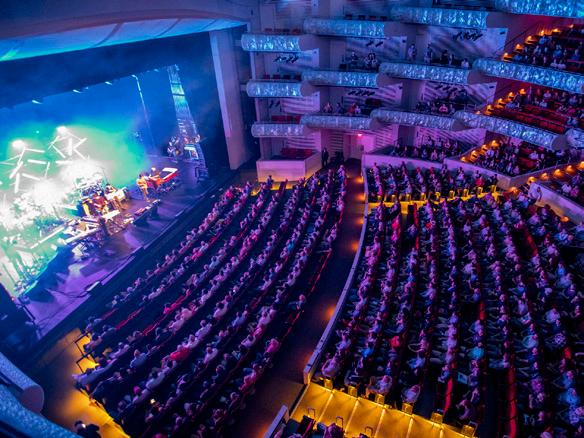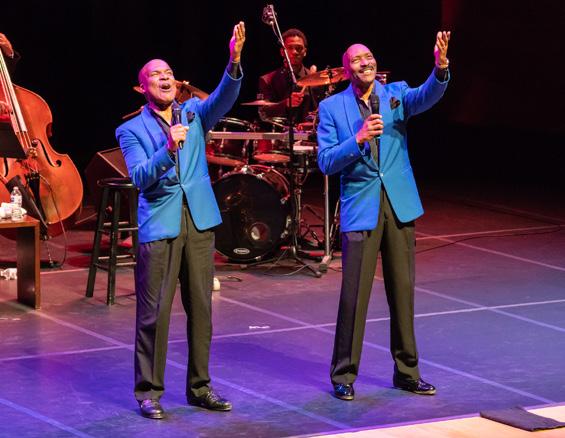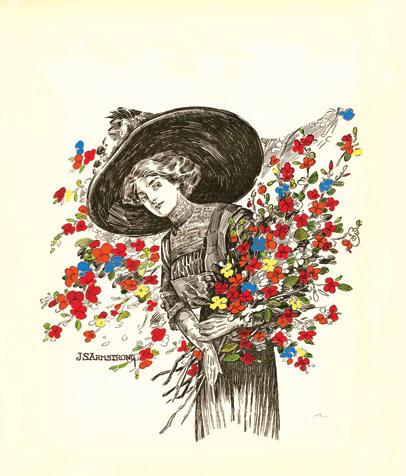ICM Orchestra with Guest Conductor
Laura Jackson


MARCH 15, 2024 • 7:30 P.M.





MARCH 15, 2024 • 7:30 P.M.





Dear Esteemed Patrons and Devotees of Music,
It’s not merely the notes that create a melody but the passion and dedication behind each one. As the Artistic Director of the International Center for Music, my journey in music has been deeply personal and profoundly enriching. The same fervor that drove me to delve into the depths of musical discipline drives our students, faculty, and guests artists. Their commitment to their craft is not only a source of endless inspiration but also what sets our program apart.
Kansas City is truly privileged, as within its bounds lies an audience with an appetite for genuine talent and a heart that beats in rhythm with the finest melodies. Our concert series provides an invaluable opportunity to experience this prodigious talent in an accessible manner, making world-class music available to all.
Our mission at the International Center for Music at Park University has always been clear – to offer an environment reminiscent of the intensive training I was fortunate to undergo, a space free from distractions where the sole focus is on achieving musical excellence without the burden of financial pressures.
In addition to our homegrown prodigies, the ICM Concert Series is also graced by legendary guest performers, individuals whose contributions to the world of music have been monumental.
As we usher in another season of musical brilliance, I warmly invite you to be a part of our melodious journey. Come, immerse yourself in a world where past, present, and future converge in harmonious symphony.
With profound gratitude,
 Stanislav Ioudenitch Founder and Artistic Director International Center for Music at Park University
Stanislav Ioudenitch Founder and Artistic Director International Center for Music at Park University
P.S. Each performance is a manifestation of our shared love for music. Your presence and applause amplify our drive to elevate the art form further.
STEVEN MCDONALD, MUSIC DIRECTOR
The Wilderness Anthology
- Reverence/Dusk
- Jungle Disco
- Desert Doldrums
- Dawn Chorus
Patrick Harlin (1984)
Introduction and Allegro for Quartet and Strings, op.47
Sir Edward Elgar (1857-1934)
Mumin Turgunov, violin I
Ilkhom Mukhiddinov, violin II
Christian dos Santos, viola
James Farquhar, cello
Intermission
String Quartet in D Minor, D.810, “Death and the Maiden”
Arr. Gustav Mahler (1860-1911)
I. Allegro
II. Andante con moto
III. Scherzo: allegro molto
IV. Presto
Franz Schubert (1797-1828)

Laura Jackson serves as music director and conductor of Nevada’s Reno Philharmonic Orchestra. She wins praise for her passionate artistry, creative leadership, and commitment to community engagement. Laura is known nationally and internationally for both her innovative composer-in-residence projects and vibrant performances of traditional repertoire. She has cemented the Phil’s place in the hearts of northern Nevadans while also raising the institution to new musical heights and national visibility.
In addition to concerts with the Reno Phil, Ms. Jackson guest conducts nationally and internationally. She has performed with the symphonies of Alabama, Atlanta, Baltimore, Berkeley, Charlottesville, Detroit, Hartford, Hawaii, Orlando, the Philippines, Phoenix, Richmond, San Antonio, Toledo, Toronto, Windsor, and Winnipeg in addition to concerts with the Philly Pops and L’Orchestre symphonique de Bretagne in France.
Jackson recorded Michael Daugherty’s Time Cycle on Naxos with the Bournemouth Symphony in partnership with Marin Alsop, and served as the first American to guest conduct the Algerian National Orchestra in 2013.
Jackson served as the first female assistant conductor of the Atlanta Symphony Orchestra from 2004-07. Prior to her appointment in Atlanta, she studied conducting at the University of Michigan and spent summers as the Seiji Ozawa Conducting Fellow at the Boston Symphony Orchestra’s Tanglewood Music Center in 2002 and 2003.
Ms. Jackson spent her early childhood in Virginia and Pennsylvania before moving at age 11 to Plattsburgh, NY, where she grew up waterskiing, swimming, and sailing on Lake Champlain. She fell in
love with the violin in public school, later attending the North Carolina School for the Arts to finish high school. She pursued an undergraduate degree at Indiana University where she studied both violin and conducting before moving to Boston in 1990 to freelance as a violinist and teach at Phillips Exeter Academy in New Hampshire.
The Park Quartet is composed of students from the International Center for Music at Park University with a variety of degrees in music performance plus vast chamber music experiences. The four musicians hail from the U.S. (Cello: James Farquhar), Brazil (Viola: Christian dos Santos), and Uzbekistan (Violin: Ilkhom Mukhiddinov, Mumin Turgunov).
Founded in 2022, the quartet has been actively performing around the Kansas City Metro Area. Plus, since reaching diverse communities outside concert halls is an important part of the group’s mission, Park Quartet makes chamber music accessible for all by connecting with artistic activities in churches, public libraries and senior centers. The group also serves as an important part of the International Center for Music’s outreach to the community. From the start, the Quartet has been programming and performing chamber music masterpieces such as string quartets by Mendelssohn, Dvorak, Mozart, and Debussy, to name a few, as well as presenting folk tunes from Danish, Brazilian, and other cultures.
The Park Quartet is supported and coached by Daniel Veis and Ben Sayevich, professors from the International Center for Music. They’ve also had the pleasure to work with artists such the violinist Shmuel Ashkenasi at the Graham Tyler Memorial Chapel Hall in Parkville, Mo., and conductor Michael Stern at the Kauffman Center for Performing Arts in Kansas City, Mo.

James Farquhar is currently a student of Daniel Veis, pursuing a Master’s Degree in Cello Performance from Park University’s International Center for Music. He is formerly a student of Kurt Baldwin of the Arianna String Quartet at the University of Missouri – St. Louis. Under Baldwin’s instruction, James attained 2019-20 UMSL Artist of the Year with the Rococo Variations by Tchaikovsky. In Spring of 2022, he was also named Odyssey Chamber Music’s Performance Fellow, with a culminating solo recital, in collaboration with pianist Peter Miyamoto (University of Missouri’s professor for piano). During his time pursuing his undergraduate degree, James organized numerous community recitals around St. Louis and Kansas City.
He has received invaluable instruction from the likes of the Arianna String Quartet, the Brooklyn Rider String Quartet, the Harlem String Quartet, the Jupiter String Quartet, the Rolston String Quartet, Dennis Parker, Scott Lee, Jackie Lee, Frank Huang, Michael Stern and Shmuel Ashkenazy, among numerous others. James has also participated in various chamber music festivals including the Arianna Chamber Music Festival, Madeline Island Chamber Music Festival, Heartland Chamber Music Festival (as a festival scholar from the 2017-22 seasons), and Chamber Music in the Mountains (Mt. Lemmon, Arizona).
James is a Teaching Artist for Harmony Project KC, a nonprofit that provides year round music education for underserved students from the diverse Historic Northeast Community of Kansas City, Missouri. This program’s main goal is to get students access to college through music. Their first graduating class in 2022 was able to get approximately 95 percent of their college covered by
financial aid and merit-based scholarships. Many of the students plan to use their education to improve the lives of their underserved community members. He also aspires to organize grant-funded outreach concerts for underserved elementary schools, hospitals and nursing home communities. James performs on an 18th Century composite cello crafted by Giovanni Tononi. This instrument is generously on loan from the Rachel Barton Pine Foundation.

Christian dos Santos
Christian Santos started his journey playing the Viola in 2012 in Sao Paulo, Brazil, at the age of 13. He studied at the Sao Paulo State Music School with violists Mariana Costa Gomes and Silvio Catto before becoming a student of Peter Chun at the International Center for Music at Park University. Christian has performed with several orchestras such as the Brazilian National Symphony Orchestra, Bauru Symphony Orchestra, Lins Youth Symphony Orchestra, and the exceptional Sao Paulo State Youth Orchestra, with which he recorded CDs with masterpieces such as Mahler’s 5th Symphony, Bartok’s Miraculous Mandarin, Kodaly’s Dances of Galanta, Claudio Santoro’s 9th Symphony, to name a few. In these orchestras he performed with prestigious conductors such as Giancarlo Guerrero, Marin Alsop, Michael Tilson Thomas, Neil Thompson, Claudio Cruz, Marcelo Leningher, Michal Klauza, Bruno Mantovani, and others.
When it comes to chamber music, Christian had amazing experiences in the Pianosofia (directed by the pianist Cristian Budu), Martinez Quartet, and Sao Paulo State Youth Orchestra String Quartet. He has had opportunities to work with other musicians such as Christoph Hartmann (Berlin Phil), Jon Thorne (London Phil), Shmuel Ashkenasi (Curtis), Ben Sayevich (Park University), Daniel Veis (Park University), the Modigliani Quartet members, etc. Currently, Christian is the violist of the Park Quartet at the International Center for Music and Viola Principle of the ICM Chamber Orchestra.
In music festivals, solo masterclasses, and international activities, Christian worked with artists such as Hsin Yun-Huang (Juilliard), Ruth Killius, Tim Deighton (Penn State), Hong Mei-Xiao (University of Arizona), Rafael Altino (Carl Nielsen Academy) Antal Zalai, Asbjørn Nørgaard (Danish Quartet), Agata Szymczewska (13th Wieniawski Winner), Antonio Meneses, to name a few. He also worked as guest and side-by-side performer for the New World Symphony, Youth Orchestra of Americas, and Boston Youth Symphony.

Uzbekistan-born violinist Ilkhom Mukhiddinov has won acclaim for his high professionalism. His extraordinary technical abilities transmit a fresh interpretation of standard and contemporary classical repertoire. Born in Tashkent in 2001 into a family of musicians, Ilkhom started his musical journey in the Uspensky Specialized Music Lyceum. Ilkhom made his debut with the Uspensky Symphony Orchestra at the age of 7. Since 2012, Ilkhom has been named prize winner of over 10 competitions and festivals. Some of his recent awards include first prize at the Hellam Young Artist Competition, finalist and “Jury special mention” at the Leonid Kogan international Competition, and 1st Prize at the Naftzger competition. Ilkhom has worked with a number of internationally recognized concert artists and pedagogues such as Miriam Fried, Shmuel Ashkenasi, Gil Shaham, Nicholas Kitchen, Ani Kavafian, Mark Kaplan, Danny Phillips, Francesca dePasquale and Jaime Laredo.
Since 2012, Ilkhom has been named prize winner of over 10 competitions and festivals. Some of his recent awards include first prize at the Hellam Young Artist Competition, finalist and “Jury special mention” at the Leonid Kogan international Competition, and 1st Prize at the Naftzger competition. Ilkhom has worked with a number of internationally recognized concert artists and pedagogues such as Miriam Fried, Shmuel Ashkenasi, Gil Shaham, Nicholas Kitchen,
Ani Kavafian, Mark Kaplan, Danny Phillips, Francesca dePasquale and Jaime Laredo. Currently Ilkhom is pursuing a Graduate Certificate in Music Performance at the International Center for Music at Park University, where he studies with Ben Sayevich.

Muminjon Turgunov is a student of Ben Sayevich currently working on his Bachelor’s Degree in Violin Performance. Prior coming to the United States in 2019 he studied for 11 years at the Glier School of Music in Tashkent, Uzbekistan, with such renowned teachers as Nikitin Yaroslav and more. In 2018 started working as a concertmaster of “Consonanza” Chamber Orchestra at the Tashkent and Uzbekistan Diocese. In the same year was awarded a Diploma for the Best Musician of the Season “Spring 2018”. In 2019 Muminjon participated in the Republican Competition of Uzbekistan and won 2nd prize. In 2020 Muminjon Turgunov was privileged to work as a full time violinist in the “State Symphony Orchestra”. He has a passion for playing violin solo repertoire, but greatly enjoys playing in chamber ensembles and orchestras. From 2022 till current days Mumin Turgunov won a position as a substitute violinist in the Kansas City Symphony. In the Summer of 2023 Mumin was privileged to be part of the National Repertory Orchestra under Michael Stern.

Originally from Reading, Mass., Steven McDonald, director of orchestral activities, has served on the faculties of the University of Kansas, Boston University and Gordon College. While in Boston, he conducted a number of ensembles, including Musica Modus Vivendi, the student early music group at Harvard University. McDonald also directed ensembles
at the Massachusetts Institute of Technology, serving as founder and music director of the Summer Opera and Independent Activities Period Orchestra, and conductor of the MIT Chamber Orchestra and the Gilbert and Sullivan Players.
At the University of Kansas, McDonald served as assistant conductor of the KU Symphony, and was the founder and music director of the Camerata Ensemble of non-music majors, and of the chamber orchestra “Sine Nomine,” a select ensemble of performance majors. Additionally, he has conducted performances of the KU Opera. He has also served as vocal coach at the Boston University Opera Institute and at Gordon College.
McDonald served as music director of the Lawrence (Kan.) Chamber Orchestra from 2007-14, during which time the group transformed into a professional ensemble whose repertoire featured inventive theme programs and multimedia performances.
In 2009, he was selected to conduct the Missouri All-State High School Orchestra, and in 2011 was the first conductor selected as guest clinician at the Noel Pointer Foundation School of Music which serves inner-city students in Brooklyn, N.Y. An avid proponent of early music, McDonald has also taught Baroque performance practice at the Ottawa Suzuki Strings Institute summer music program, and regularly incorporates historically informed practice into his performances.
McDonald is a graduate of the Boston University School for the Arts, the Sweelinck Conservatory of Amsterdam (The Netherlands) and the University of Kansas School of Fine Arts. His teachers have included Brian Priestman, Nicholas Uljanov, Joop van Zon and Thomas Dunn for conducting, Henk van Eeuwijck and Leo Abbott for piano, Craig Rutenberg for vocal coaching and George Faxon for organ.
Steven
Violin I
Mumin Turgunov, concertmaster
Soobeen Nam
Ilkhom Mukhiddinov
Aviv Daniel
Eva Dove
Vincent Cart-Sanders
Galo Alboreda
Violin II
Alice Palese, principal
Yin-Shiuan Ting
Yuren Zhang
Isaac Villaroya
Casey Gregory
Matthew Bennett
Sun-Young Shin
Viola
Christian dos Santos, principal
Victor Diaz
Ali Golozar
Andrew Bonci
Shelley Armer
Peter Chun
Cello
James Farquhar, principal
Mardon Abdurakhmonov
Diyorbek Nortojiyev
Ainaz Jalilpour
Jordan Proctor
Otabek Guchkulov
Bass
Kassandra Ferrero
Minjoo Hwangbo

Patrick Harlin’s musical outlook has been shaped by his research into “soundscape ecology,” which is a means of trying to better understand ecosystems by listening to, and recording, natural sounds. His travels have taken him to remote places with especially endangered ecosystems, such as the Amazon rainforest and the Book Cliffs of Utah.
His aesthetics “capture a sense of tradition and innovation,” according to The New York Times, by merging a vision of the great outdoors with a mastery of compositional form, texture, and color. Born in Salt Lake City and raised in Seattle, Harlin earned his Bachelor of Music from Western Washington University in Bellingham, Washington, and his Master’s and D.M.A. from the University of Michigan. His teachers have included Alexei Girsh, Roger Briggs, Evan Chambers, Bright Sheng, and Michael Daugherty.
Harlin’s compositions join his love of jazz and electronic music with a passion for the classical tradition. He served as the Lansing Symphony Orchestra’s inaugural Composer in Residence and his works have been performed by the orchestras of St. Louis, Kansas City, and Calgary; the Collegium Cincinnati; and the Calidore String Quartet. He has received a Graham Sustainability Institute Doctoral
Fellowship, a Theodore Presser Award, and a University of Michigan Predoctoral Fellowship. Among his recorded works are Rapture featuring the Rochester Philharmonic on Azika Label, #tbt, which is part of Naxos’ My Time is Now recording (featuring the use of George Gershwin’s restored Steinway piano), and River of Doubt.
His compositions include works for orchestra, band, and chamber ensembles, and vocal and solo music. A significant part of his output are the many soundscapes, recorded in natural settings around the world, which have often inspired highly-effective compositions exploring these sounds using other tools (such as conventional musical instruments). Most significant among these is The Wilderness Anthology, which received its premiere in 2016. It is subtitled A Preservation of Sonic Landscapes for String Quartet and Pre-recorded Audio. Tonight’s performance includes four of the anthology’s seven movements: Reverence-Dusk, Jungle Disco, Desert Doldrums, and Dawn Chorus. The composer has written the following note about the piece:
“The Wilderness Anthology (2014-2016) is a music composition for string quartet and pre-recorded audio soundscapes from the Peruvian Amazon Rainforest and Book Cliffs in the Utah and Colorado. The work employs audio from these environmentally imperiled disappearing soundscapes ... with live string quartet drawing relationships between sounds found in the natural world and those in the concert hall.
“Though almost entirely overlooked in the field of sustainability, soundscapes are a critical component of an ecosystem, a potential indicator of biodiversity, a valuable tool in predator and prey dynamics, and a clear signal in a frequently visually cluttered or camouflaged landscape. The Book Cliffs and portions of the Amazon where these recordings were gathered are virtually uninhabited but under continual pressure for resource extraction. Through a combination of habitat loss, species decline, ecological destruction, and resource extraction, soundscapes are becoming less apparent and acoustically diverse.
“Human generated noise masks sound from biological and geographic sources, while technology increasingly insulates humans inside of an artificial sound environment. This lack of attention and awareness, coupled with noise pollution and environmental degradation, is permanently altering soundscapes and ecosystems. The Wilderness Anthology focuses listener’s attention on this issue.
“The Wilderness Anthology employs the transcription of bird calls and imitation of a soundscape by the performers, and it evokes the visual and the romanticized ideal of humans in nature. Evocation is achieved through suspended harmonic rhythm, heightened activity, and string harmonics simulating tinnitus which is apparent in quiet places.
“It is ideally performed in a concert hall with a high-fidelity audio system for audio playback. The work can be performed with or without projected images. The audio was recorded on location in 2013-14 with a Sound Devices 702 recorder and a pair of DPA 4006 stereo microphones. The audio is packaged in a MaxMSP patch and triggered by a Logidy midi-pedal.”

Elgar was a bit of a musical celebrity at the turn of the 20th century. His early maturity, which had produced the Serenade for Strings, the Enigma Variations, and the initial Pomp and Circumstance Marches,
Edward Elgar (1857-1934): Introduction and Allegro for Strings Edward Elgar _ ca1905reached new heights with the enormously effective oratorio The Dream of Gerontius and the concert overture In the South
A three-day festival of Elgar’s works in 1904 confirmed a growing notion that he was the natural successor to Sir Arthur Sullivan (who died in late 1900) as the primary English composer of the day. In July 1904 he was knighted by King Edward VII at Buckingham Palace, receiving the sort of official recognition that his wife, Alice, had long felt was due him. In the ensuing years “Sir Edward” also visited the United States, where he was warmly feted and, among other things, received an honorary doctorate from Yale University.
The first decades of the 20th century also saw the emergence of the first “modern” English orchestras, beginning in 1904 with the London Symphony Orchestra — formed from players who had defected from Henry Wood’s Queen’s Hall Orchestra when its leadership tried to bind the already underpaid players to exclusivity. Thus was born one of the first musician-operated orchestras, which to this day functions as a self-governing body. The new ensemble included a number of Queen’s Hall’s best, and they invited Elgar to conduct a concert of his works, including a new composition. His friend August Jaeger (the inspiration for the Nimrod movement of the Enigma Variations) suggested to Elgar that he show off the string section. “Why not a brilliant quick String Scherzo or something for those fine strings only?” Jaeger wrote. “A real bring-down-the-house torrent of a thing, such as Bach could write?” Elgar responded to the challenge with a uniquely virtuoso work with “a devil of a fugue,” as he stated — scored for solo quartet and a string section that divides into as many as 10 parts.
In his own program note for the piece, Elgar writes of being inspired by a Welsh tune he overheard (first played here by solo viola about a minute into the piece). “In Cardiganshire (Wales), I thought of writing a brilliant piece for string orchestra. On the cliff, between the blue sea and blue sky, thinking out my theme, there came up to me the sound of singing. The songs were too far away to reach me distinctly, but one point common to all was impressed upon me, and led me to think, perhaps wrongly, that it was a real Welsh idiom — I mean the
fall of a third. … Fitting the need of the moment, I made the tune which appears in the Introduction (as a link) and in the Coda of this work… I hope there is a Welsh feeling in the one theme. … The work is really a tribute to that sweet borderland where I have made my home.” The exact song has not been identified: Some believe that Elgar’s tune might simply be a melody “in the style of” Welsh folk song. Another striking aspect of this piece is the evocation of the Baroque concerto grosso suggested by the solo-versus-group layout — a powerful use of contrasting color and texture that perhaps had an impact on Vaughan Williams’ similarly-scored Fantasia on a Theme of Thomas Tallis.
A typically Baroque introduction of emphatic chords gives way to an urgent first theme (Allegretto) and to the introduction of the “Welsh” tune in the viola. A rapid-fire concitato passage leads to the march-like fugue (Allegro), built from a dizzying subject that gives the players plenty to chew on. A return to the Allegretto theme brings us back to a full-ensemble reiteration (fortissimo and molto sostenuto) of the Welsh tune.
 by JosefKriehuber
by JosefKriehuber
The practice of arranging other composers’ works was common until around the middle of the 20th century, when a shift in attitude
Franz Peter Schubert (1797-1828); arr. Gustav Mahler: String Quartet No. 14 in D minor, D. 810 (“Death and the Maiden”)caused us to begin regarding an artist’s “original” as primary. Franz Liszt famously created piano versions of the Beethoven symphonies and other works, and composers of the 18th and 19th centuries felt free to create chamber or four-hand piano versions of their symphonies for home consumption.
For composer-conductors such as Mahler, arranging was sometimes a form of “modernizing” Baroque and Classical-period music: The practice often consisted of expanding wind parts and even inserting new lines of music into an existing texture. Mahler left a large body of arrangements of Bach (excerpts from the Orchestral Suites), Schubert (the “Great” Symphony), Bruckner (Symphonies 3 and 5), and all of the symphonies of Beethoven and Schumann. He also arranged and/or touched up operas by Mozart, Wagner, and Weber, including a completion of the latter’s unfinished Die drei Pintos.
This was the work of an active conductor who perhaps felt that his audiences expected a bit more oomph from an orchestral sound. (Remember that Mahler’s orchestra had double the number of strings as Beethoven’s orchestra but the same number of winds and brass instruments.) Some regard these as “re-compositions” in the Postmodern sense, even though Mahler would probably not have considered them “his” works. Many other 20th-century conductors engaged in this practice: Strauss, Richter, von Bülow, Mengelberg, Toscanini, Furtwängler, Walter, and Stokowski, to name a few.
Two chamber-orchestra arrangements of string quartets that Mahler admired (Beethoven’s Op. 95 and Schubert’s “Death and the Maiden”) stand perhaps as experiments, but they were also intended for performance. The Schubert remained unpublished during the composer’s lifetime: In fact Mahler had merely left instructions as to how the quartet should be adapted. It was later completed by scholars David Matthew and Kenneth Woods, and Mahler superfan Gilbert Kaplan conducted the premiere in Carnegie Hall in 1984. Little has changed from quartet to chamber version, note-wise, beyond decisions about divisions (especially of the cellos). Yet the fuller texture makes us ever-mindful of the revolutionary power of this work from 1824.
Schubert’s songs occupied such a central place in his own aesthetic (he composed some 600 of them) that we can hardly blame him for wanting to re-use them at every possible occasion. His use of a familiar melody in an instrumental work often functioned as a sort of “inside joke,” meant only for those in his circle of friends: who were acquainted with the songs. Thus “Die Forelle” became source material for the “Trout” Quintet and “Der Wanderer” sparked the “Wanderer” Fantasy.
Most striking of all was the use of “Der Tod und das Mädchen” in the D-minor String Quartet: For not only does the song’s haunting tune form the basis of a set of melancholic variations, but motivic fragments of the tune are used as essential structural elements throughout the piece. The poem, by German Romantic poet Matthias Claudius, tells of a young girl who gradually becomes reconciled with the reality of death, while Death himself sings soothingly to assuage her fear.
The quartet remains one of Schubert’s most sublime achievements, and although it was rejected by Vienna’s celebrated Schuppanzigh Quartet (which had played premieres of the late Beethoven quartets a few years earlier), it did receive a private performance in early 1826, the rehearsals of which Schubert supervised. Alas, just 18 months later Schubert was dead, aged all of 31, never having heard a public performance of his greatest quartet.
Terse and dramatic throughout, this quartet calls to mind Beethoven’s more forceful utterances, beginning with the searing triplet outburst that opens the Allegro. The restless motion of the movement is determined by reiterations of this triplet figure. The Andante con moto is a set of six variations on the “Death and the Maiden” tune, presented at the outset with straightforward grace. The Scherzo (Allegro molto) yanks us back to the hyper-charged world of the Allegro: some have called it a “dance of death.” The tarantella-style finale (Presto) brings the quartet to a lively, macabre close.






Gustavo Fernandez Agreda, ICM Coordinator
Daniel Veis, Cello Studio
Lisa Hickok, Executive Director
Ben Sayevich, Violin Studio
Lolita Lisovskaya-Sayevich, Director of Collaborative Piano
Steven McDonald, Director of Orchestra
Stanislav Ioudenitch, Founder & Artistic Director, Piano Studio
Peter Chun, Viola Studio
Not pictured: Behzod Abduraimov, Artist-in-Residence Photo: Damian GonzalezSUPPORT THE ICM, ENJOY BEAUTIFUL MUSIC AND SPECIAL EVENTS JUST FOR MEMBERS
BELOW ARE JUST A FEW OF OUR PATRONS ENJOYING GROUP EVENTS INCLUDING MEETING THE TALENTED ICM ARTISTS





FOR MORE INFORMATION ON HOW TO JOIN OUR PATRONS SOCIETY:
 John and Karen Yungmeyer
Brad and Theresa Freilich, Evelina Swartzman, Shane Smeed and Steve Swartzman
Stanislav Ioudenitch, Angela Walker and Edith and Benny Lee
Ronald and Phyllis Nolan and Vince and Julie Clark
Lolita Lisovskaya-Sayevich, Evelina Swartzman and Ihab and Colleen Hassan
John and Karen Yungmeyer
Brad and Theresa Freilich, Evelina Swartzman, Shane Smeed and Steve Swartzman
Stanislav Ioudenitch, Angela Walker and Edith and Benny Lee
Ronald and Phyllis Nolan and Vince and Julie Clark
Lolita Lisovskaya-Sayevich, Evelina Swartzman and Ihab and Colleen Hassan
The Park University International Center for Music’s Patrons Society was founded to help students achieve their dreams of having distinguished professional careers on the concert stage.
Just as our faculty’s coaching is so fundamental to our students’ success, our Patrons’ backing provides direct support for our exceptionally talented students, concert season, outreach programs and our ability to impact the communities we serve through extraordinary musical performances.
We are continually grateful for each and every one of our Patrons Society members. For additional information, please visit ICM.PARK.EDU under “Support Us.”
We gratefully acknowledge these donors as of February 20, 2024. * 2023-2024 Member
Brad and Marilyn Brewster *
Steven Karbank *
Benny and Edith Lee *
Ronald and Phyllis Nolan *
John and Debbie Starr *
Steven and Evelina Swartzman *
Jerry White and Cyprienne Simchowitz *
Richard J. Stern Foundation for the Arts – Commerce Bank, Trustee *
Jeffrey Anthony *
Brad and Theresa Freilich *
Shirley and Barnett C. Helzberg Jr. *
Lockton Companies Inc.
Muriel McBrien Kauffman Family Foundation
Holly Nielsen *
Mark Ptashne and Lucy Gordon
Steinway Piano Gallery of Kansas City *
Gary and Lynette Wages *
Tom and Mary Bet Brown
Vince and Julie Clark *
The DeBruce Foundation
Stanley Fisher and Rita Zhorov *
Edward and Sandra Fried
Mark One Electric Co.
Susan Morgenthaler *
Perspective Architecture & Design, LLC / Matt and Rhonda Masilionis
William and Susie Popplewell
Rex and Lori Sharp
Kay Barnes and Thomas Van Dyke *
Lisa Browar *
Bryan Cave Leighton Paisner
Wm. Robert Bucker
Cluen Family Fund
Mark and Gaye Cohen *
Paul and Bunni Copaken
Suzanne Crandall *
Scott and Claudia Davis
Beverly Lynn Evans
Paul Fingersh and Brenda Althouse
Jack and Pella Fingersh
J. Scott Francis and Susan Gordon
Donald Hall
Doris Hamilton and Myron Sildon *
Colleen and Ihab Hassan *
Lisa Merrill Hickok *
JE Dunn Construction Company
William and Regina Kort *
Dean, ‘53 and Charlotte Larrick
Brian McCallister / McCallister Law Firm
Mira Mdivani / Mdivani Corporate Immigration Law Firm
Jackie and John Middelkamp *
Louise Morden
Kathleen Oldham *
Susan and Charles Porter
Kevin and Jeanette Prenger, ’09 / ECCO Select *
Steve and Karen Rothstein
Stanley and Kathleen Shaffer *
Shane and Angela Smeed *
Straub Construction
Guy Townsend *
John and Angela Walker *
Nicole and Myron Wang *
WSKF Architects
The Park University International Center for Music Foundation exists to secure philanthropic resources that will provide direct and substantial support to the educational and promotional initiatives of the International Center for Music at Park University. With unwavering commitment, the Foundation endeavors to enhance awareness and broaden audiences across local, national, and international spheres.
Vince Clark, Chair
Steve Karbank, Secretary
Benny Lee, Treasurer
Marilyn Brewster
Lisa Browar
Stan Fisher
Brad Freilich
Holly Nielsen
Ron Nolan
Shane Smeed
John Starr
Steve Swartzman
Guy Townsend
Angela Walker
 Front row, from left – Stanley Fisher, Marilyn Brewster, Benny Lee, Ronald Nolan, Lisa Browar. Back row, from left: John Starr, Steve Swartzman, Vince Clark, Shane Smeed, Bradley Freilich, Guy Townsend, Steve Karbank.
Front row, from left – Stanley Fisher, Marilyn Brewster, Benny Lee, Ronald Nolan, Lisa Browar. Back row, from left: John Starr, Steve Swartzman, Vince Clark, Shane Smeed, Bradley Freilich, Guy Townsend, Steve Karbank.





ICM.PARK.EDU.

The Los Angeles Times has reported, “Uzbekistani pianist Behzod Abduraimov is fast becoming one of the finest musicians of his generation.” The 33-year old Park ICM alum will be joined in concert by violinist Daniel Lozakovich. “Daniel is one of the greatest stars of the young generation...Very hot,” said Behzod’s mentor Stanislav Ioudenitch. Together they will perform works by Beethoven, César Franck and the Sonata No. 1 for violin and piano in A minor, Op. 105 by Schumann. Behzod Abduraimov, Piano, Daniel Lozakovich, Violin
APRIL 14, 2024, 7:30 P.M. 1900 BUILDING
GEN ERAL ADMISSION $30. STUDENTS $10 WITH I.D.










Park University will present its final concert of the 2023-24 season on Friday, April 19th at the charming chapel on campus in Parkville, Missouri. Guest Maestra Yahr has selected a program of works by Jan Sibelius, Karl Stamitz and Felix Mendelssohn.

PARK ICM
ORCHESTRA WITH BARBARA YAHR
CONDUCTING
April 19, 2024, 7:30 p.m.
Graham Tyler
Memorial Chapel
CONCERT IS FREE WITH RESERVATION. SCAN THE CODE TO RSVP.

ICM.PARK.EDU.



























A powerhouse team of 30 nationally renowned experts. Over 115 combined years of proton therapy experience. Billions of cancer cells destroyed. As leaders in our field, we pride ourselves on giving our patients the best possible odds for beating cancer. Because we know what really counts is the number of lives saved.




To see if proton therapy is right for you, call 913-588-3671 or visit KUCancerCenter.org/Proton.



